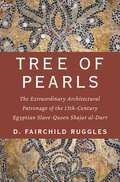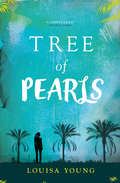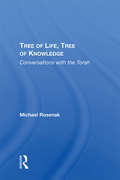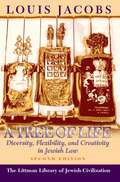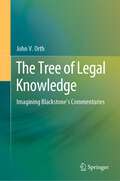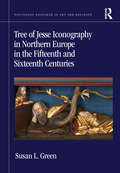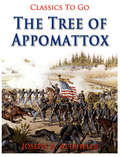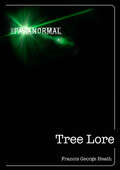- Table View
- List View
Tree of Pearls: The Extraordinary Architectural Patronage of the 13th-Century Egyptian Slave-Queen Shajar al-Durr
by D. Fairchild RugglesShajar al-Durr--known as "Tree of Pearls"--began her remarkable career as a child slave, given as property to the Ayyubid Sultan Salih of Egypt. She became his favorite concubine, was manumitted, became the sultan's wife, served as governing regent, and ultimately rose to become the legitimately appointed sultan of Egypt in 1250 after her husband's death. Shajar al-Durr used her wealth and power to add a tomb to his urban madrasa; with this innovation, madrasas and many other charitably endowed architectural complexes became commemorative monuments, a practice that remains widespread today. A highly unusual case of a Muslim woman authorized to rule in her own name, her reign ended after only three months when she was forced to share her governance with an army general from the ranks of the Mamluks (elite slave soldiers) and for political expediency to marry him. Despite the fact that Shajar al-Durr's story ends tragically with her assassination and hasty burial, her deeds in her lifetime offer a stark alternative to the continued belief that women in the medieval period were unseen, anonymous, and inconsequential in a world that belonged to men. This biography--the first ever in English--will place the rise and fall of the sultan-queen in the wider context of the cultural and architectural development of Cairo, the city that still holds one of the largest and most important collections of Islamic monuments in the world. D. Fairchild Ruggles also situates the queen's extraordinary architectural patronage in relation to other women of her own time, such as Aleppo's Ayyubid regent. Tree of Pearls concludes with a lively discussion of what we can know about the material impact of women of both high and lesser social rank in this period, and why their impact matters in the writing of history.
Tree of Pearls: The Extraordinary Architectural Patronage of the 13th-Century Egyptian Slave-Queen Shajar al-Durr
by D. Fairchild RugglesShajar al-Durr--known as "Tree of Pearls"--began her remarkable career as a child slave, given as property to the Ayyubid Sultan Salih of Egypt. She became his favorite concubine, was manumitted, became the sultan's wife, served as governing regent, and ultimately rose to become the legitimately appointed sultan of Egypt in 1250 after her husband's death. Shajar al-Durr used her wealth and power to add a tomb to his urban madrasa; with this innovation, madrasas and many other charitably endowed architectural complexes became commemorative monuments, a practice that remains widespread today. A highly unusual case of a Muslim woman authorized to rule in her own name, her reign ended after only three months when she was forced to share her governance with an army general from the ranks of the Mamluks (elite slave soldiers) and for political expediency to marry him. Despite the fact that Shajar al-Durr's story ends tragically with her assassination and hasty burial, her deeds in her lifetime offer a stark alternative to the continued belief that women in the medieval period were unseen, anonymous, and inconsequential in a world that belonged to men. This biography--the first ever in English--will place the rise and fall of the sultan-queen in the wider context of the cultural and architectural development of Cairo, the city that still holds one of the largest and most important collections of Islamic monuments in the world. D. Fairchild Ruggles also situates the queen's extraordinary architectural patronage in relation to other women of her own time, such as Aleppo's Ayyubid regent. Tree of Pearls concludes with a lively discussion of what we can know about the material impact of women of both high and lesser social rank in this period, and why their impact matters in the writing of history.
Tree of Pearls (The Angeline Gower Trilogy #3)
by Louisa YoungScintillating comic-romantic thriller, a finale to Louisa’s fab Egyptian trilogy: what life will Angeline choose?
Tree of Origin: What Primate Behavior Can Tell Us about Human Social Evolution
by F. B. WaalHow did we become the linguistic, cultured, and hugely successful apes that we are? Our closest relatives--the other mentally complex and socially skilled primates--offer tantalizing clues. In Tree of Origin nine of the world's top primate experts read these clues and compose the most extensive picture to date of what the behavior of monkeys and apes can tell us about our own evolution as a species. It has been nearly fifteen years since a single volume addressed the issue of human evolution from a primate perspective, and in that time we have witnessed explosive growth in research on the subject. Tree of Origin gives us the latest news about bonobos, the "make love not war" apes who behave so dramatically unlike chimpanzees. We learn about the tool traditions and social customs that set each ape community apart. We see how DNA analysis is revolutionizing our understanding of paternity, intergroup migration, and reproductive success. And we confront intriguing discoveries about primate hunting behavior, politics, cognition, diet, and the evolution of language and intelligence that challenge claims of human uniqueness in new and subtle ways. Tree of Origin provides the clearest glimpse yet of the apelike ancestor who left the forest and began the long journey toward modern humanity.
The Tree Of Man (Virago Modern Classics)
by Patrick WhiteStan Parker, with only a horse and a dog for company journeys to a remote patch of land he has inherited in the Australian hills. Once the land is cleared and a rudimentary house built, he brings his wife Amy to the wilderness. Together they face lives of joy and sorrow as they struggle against the environment.
Tree Of Life, Tree Of Knowledge: Conversations With The Torah
by Michael RosenakFrom the Preface: THE IDEA OF THIS BOOK came to my mind many years ago, after several conversations with my friend and colleague in Jewish educational studies Joseph Lukins professor at the Jewish Theological Seminary in New York. He had suggested that an educated Jew is, among other things, one who lives in some spiritual and cognitive proximity to the weekly Torah reading, the parashat hashavua, "portion of the week." He insisted that issues in the philosophy of education might be in the liturgy's scriptural readings,that even the way messages of tradition divided the Torah into "portions" reflected discrete modes of teaching Torah.In this book, theoretical conceptions, garnered from many places, even if they do not precede reading of Torah, are certainly prisms through which I can read it.
Tree Of Life, Tree Of Knowledge: Conversations With The Torah
by Michael RosenakFrom the Preface: THE IDEA OF THIS BOOK came to my mind many years ago, after several conversations with my friend and colleague in Jewish educational studies Joseph Lukins professor at the Jewish Theological Seminary in New York. He had suggested that an educated Jew is, among other things, one who lives in some spiritual and cognitive proximity to the weekly Torah reading, the parashat hashavua, "portion of the week." He insisted that issues in the philosophy of education might be in the liturgy's scriptural readings,that even the way messages of tradition divided the Torah into "portions" reflected discrete modes of teaching Torah.In this book, theoretical conceptions, garnered from many places, even if they do not precede reading of Torah, are certainly prisms through which I can read it.
The Tree of Life and the Holy Grail: Ancient and Modern Spiritual Paths and the Mystery of Rennes-le-Château
by Sylvia FranckeRecent works of fiction and popular history have promoted the idea that the Holy Grail symbolizes a physical bloodline resulting from the union of Jesus Christ and Mary Magdalene. This, supposedly, is the 'secret' that esoteric movements have kept tirelessly for the past 2,000 years. From her groundbreaking research, Sylvia Francke exposes this notion to be a blatant misinterpretation of the mystery traditions that preceded and ran parallel to the birth of Christianity. She traces the ancient spiritual paths of knowledge from the Cathars, the Knights Templar and the enigmatic Rosicrucians, to the work of Rudolf Steiner in the twentieth century. Here, she concludes, is true Grail knowledge: the Tree of Life and the Holy Grail itself explained in their metaphysical context. From her research she suggests a solution to the riddle of the sudden wealth and strange behaviour of Bérenger Saunière, the mysterious priest of Rennes-le-Château in southern France.True Grail knowledge, she concludes, has nothing to do with bloodlines or worldly status, but is an ancient lifeline to the spiritual origins of creation. Its energetic forces ray up from the earth and down from the constellations and planets while interacting with individual human beings. It holds the key to the fulfilment of mankind's quest, a step to the next phase of human evolution...The recent explosion of interest in an alternative history of Christianity - the shadow Grail - prompted Sylvia Francke to revise The Tree of Life and the Holy Grail, first published in 1996. The result is a completely reworked and expanded book that constitutes a powerful and convincing refutation of distorted esoteric truths.
The Tree of Life and Arboreal Aesthetics in Early Modern Literature (Routledge Studies in World Literatures and the Environment)
by Victoria BladenThe Tree of Life and Arboreal Aesthetics in Early Modern Literature explores the vital motif of the tree of life and what it meant to early modern writers who drew from its long histories in biblical, classical and folkloric contexts, giving rise to a language of trees, an arboreal aesthetics. An ancient symbol of immortality, the tree of life was appropriated by Christian ideology and iconography to express ideas about Christ; however, the concept also migrated beyond religious doctrine. Ideas circulating around the tree of life enabled writers to imagine and articulate ideas of death and rebirth, loss and regeneration, the condition of the political state and personal states of the soul through arboreal metaphors and imagery. The motif could be used to sacralise landscapes, such as the garden, orchard or country estate, blurring the lines between contemporary green spaces and the spiritual and poetic imaginary. Located within the field of environmental humanities, and intersecting with ecocriticism and critical plant studies, this volume outlines a comprehensive history of the tree of life and offers interdisciplinary readings of focus texts by Shakespeare, George Herbert, Henry Vaughan, Aemilia Lanyer, Andrew Marvell and Ralph Austen. It includes consideration of related ideas and motifs, such as the tree of Jesse and the Green Man, illuminating the rich histories and meanings that emerge when an understanding of the tree of life and arboreal aesthetics are brought to the analysis of early modern literary texts and their representations of green spaces, both physical and metaphysical.
The Tree of Life and Arboreal Aesthetics in Early Modern Literature (Routledge Studies in World Literatures and the Environment)
by Victoria BladenThe Tree of Life and Arboreal Aesthetics in Early Modern Literature explores the vital motif of the tree of life and what it meant to early modern writers who drew from its long histories in biblical, classical and folkloric contexts, giving rise to a language of trees, an arboreal aesthetics. An ancient symbol of immortality, the tree of life was appropriated by Christian ideology and iconography to express ideas about Christ; however, the concept also migrated beyond religious doctrine. Ideas circulating around the tree of life enabled writers to imagine and articulate ideas of death and rebirth, loss and regeneration, the condition of the political state and personal states of the soul through arboreal metaphors and imagery. The motif could be used to sacralise landscapes, such as the garden, orchard or country estate, blurring the lines between contemporary green spaces and the spiritual and poetic imaginary. Located within the field of environmental humanities, and intersecting with ecocriticism and critical plant studies, this volume outlines a comprehensive history of the tree of life and offers interdisciplinary readings of focus texts by Shakespeare, George Herbert, Henry Vaughan, Aemilia Lanyer, Andrew Marvell and Ralph Austen. It includes consideration of related ideas and motifs, such as the tree of Jesse and the Green Man, illuminating the rich histories and meanings that emerge when an understanding of the tree of life and arboreal aesthetics are brought to the analysis of early modern literary texts and their representations of green spaces, both physical and metaphysical.
A Tree of Life: Diversity, Flexibility and Creativity in Jewish Law [Second Edition] (The Littman Library of Jewish Civilization)
by Louis JacobsThis study of the Jewish legal system (the Halakhah) demonstrates that the law embraces every corner of life.
The Tree of Legal Knowledge: Imagining Blackstone’s Commentaries
by John V. OrthThis book restores to view a masterpiece of beauty and legal scholarship, which has been lost for almost two hundred years. Produced anonymously in 1838, The Tree of Legal Knowledge is an elaborate visualization in five large colored plates of the law as stated in Sir William Blackstone’s Commentaries on the Laws of England. Intended as “an assistant for students in the study of law,” the study aid was not a simple diagram but a beautiful tree with each branch and twig labeled with legal terms and concepts from the Commentaries. Not for law students only, the original was also intended to be of use to the practicing attorney and educated gentleman “in consolidating his learning and forming an instructive and ornamental appendage to an office.” Although Blackstone’s Commentaries had been first published eighty years earlier, it remained the primary source for knowledge of English law and required reading for American law students. The Commentaries remain relevant today and are frequently cited by the U.S. Supreme Court as a source for the original understanding of legal rights and obligations at the time of American Independence. Despite its artistic beauty and academic significance, The Tree of Legal Knowledge had seemingly disappeared shortly after its publication. It is not included in the collection of any library, including the Library of Congress or in Yale University’s Blackstone Collection, the largest in the world. It is not listed in the comprehensive Bibliographical Catalog of William Blackstone, edited by Ann Jordan Laeuchli, published for the Yale Law Library in 2015. The present volume reproduces the only extant copy of The Tree of Legal Knowledge. It includes an introduction by the editor that places The Tree in historical context and identifies the anonymous author, an otherwise unknown lawyer. In addition, it reprints the original author’s introduction and “explanation of the branches,” both extensively annotated. This book restores this lost masterpiece to its proper place in legal history. The Tree is a beautiful—and accurate—depiction of English law as expounded in Blackstone’s Commentaries, the single most important book in the history of the common law.
Tree of Knowledge, Tree of Life
by Richard ChartresThe Bishop of one of the richest dioceses in the world (London), Richard Chartres is passionately concerned with preaching the Christian Gospel. For Chartres wisdom is a way of being in the world, respectful of other human beings, taking life, not for granted, but with thanksgiving to its Author.Having set out his basic theme in the first chapter, Bishop Chartres invites the reader to join him through the Church's year. At every turn he addresses the human condition of modern men and women and opens our eyes to endless possibilities in living the Gospel.
The Tree of Knowledge: The Bright and the Dark Sides of Science
by Claudio RonchiWhether considered a divine gift or a Promethean conquest, science has indisputably and indelibly marked the course of human history. A product of the intellectual elite, but always nourished by the many fruits of its applications, science appears today to be a perfect system, whose laws and discoveries guide all human activities. Yet the foundations of its authority remain an open question, entailing disquieting aspects that are also to be identified in modern science. Furthermore it is seen to be exerting an increasing power over mankind. Readers are invited to follow an itinerary through the history of science, a voyage which, in the end, enables them to catch a glimpse of two divergent futures: One in which science accelerates the downfall of Homo sapiens, and another in which it helps our species to engage in a new and positive adventure, whose outcome nobody can know.
Tree of Jesse Iconography in Northern Europe in the Fifteenth and Sixteenth Centuries (Routledge Research in Art and Religion)
by Susan L. GreenThis book is the first detailed investigation to focus on the late medieval use of Tree of Jesse imagery, traditionally a representation of the genealogical tree of Christ. In northern Europe, from the mid-fifteenth to the early sixteenth centuries, it could be found across a wide range of media. Yet, as this book vividly illustrates, it had evolved beyond a simple genealogy into something more complex, which could be modified to satisfy specific religious requirements. It was also able to function on a more temporal level, reflecting not only a clerical preoccupation with a sense of communal identity, but a more general interest in displaying a family’s heritage, continuity and/or social status. It is this dynamic and polyvalent element that makes the subject so fascinating.
Tree of Jesse Iconography in Northern Europe in the Fifteenth and Sixteenth Centuries (Routledge Research in Art and Religion)
by Susan L. GreenThis book is the first detailed investigation to focus on the late medieval use of Tree of Jesse imagery, traditionally a representation of the genealogical tree of Christ. In northern Europe, from the mid-fifteenth to the early sixteenth centuries, it could be found across a wide range of media. Yet, as this book vividly illustrates, it had evolved beyond a simple genealogy into something more complex, which could be modified to satisfy specific religious requirements. It was also able to function on a more temporal level, reflecting not only a clerical preoccupation with a sense of communal identity, but a more general interest in displaying a family’s heritage, continuity and/or social status. It is this dynamic and polyvalent element that makes the subject so fascinating.
The Tree of Heaven: Revised Edition Of Original Version (Classics To Go)
by May SinclairMay Sinclair was the pseudonym of Mary Amelia St. Clair (24 August 1863 – 14 November 1946), a popular British writer who wrote about two dozen novels, short stories and poetry. She was an active suffragist, and member of the Woman Writers' Suffrage League. “The Tree of Heaven” is a masterly analysis of the younger generation in England--the generation which only a few years ago was condemned as neurotic and decadent and which has vindicated itself by such devotion and simpleness of heart in the ordeal of the war. (Excerpt from Wikipedia)
Tree Of Hands: a compulsive and darkly compelling psychological thriller from the award winning Queen of Crime, Ruth Rendell (Camden Ser.)
by Ruth RendellOnce when Benet was about fourteen she and her mother had been alone in a train carriage - and Mopsa had tried to stab her with a carving knife. It was some time since Benet had seen her psychologically disturbed mother. So when Mopsa arrived at the airport looking drab and colourless in a dowdy grey suit, Benet tried not to hate her. But then the tragic death of a child begins a chain of deception, kidnap and murder in which three women are pushed to their psychological limit. Winner of the Crime Writers' Association Silver Dagger in 1984 and shortlisted for the Mystery Writers of America Edgar Awards. Adapted into a hit thriller film starring Lauren Bacall.
The Tree of Gernika: A Field Study of Modern War
by G. L. SteerThe Tree of Gernika: a Field Study of Modern War was published in 1938. It is G. L. Steer's masterpiece. Martha Gellhorn famously wrote to Eleanor Roosevelt:'You must read a book by a man names Steer: it is called The Tree of Gernika. It is about the fight of the Basques - he's the London Times man - and no better book has come out of the war and he says well all the things I have tried to say to you the times I saw you, after Spain. It is beautifully written and true, and few books are like that, and fewer still deal with war. Pleas get it.'As Paul Preston says in his We Saw Spain Die, 'Martha Gellhorn's judgement has more than stood the test of time.' In his introduction, Nick Rankin writes.' The Tree of Gernika tells how Euzkadi, the democratic republic that the Basques created in their green homeland by the Bay of Biscay, fought for freedom and decency in an atrocious civil war. After a year of struggle, blockaded by sea, bombed from the air, fighting against overwhelming odds in their own hill, the Basques in the end lost to Franco's forces - but they lost honourably, without resorting to murder, torture and treachery.' It was Steer who alerted the world to the destruction of Gernika (Basque spelling), Guernica (Spanish spelling). It was the most important dispatch of his life, run by both The Times and The New York Times. Nick Rankin rightly describes The Tree of Gernika as 'a masterpiece of narrative history and eyewitness reporting by someone close to the key events . . .'
The Tree of Appomattox: A Story Of The Civil War's Close (Classics To Go #Vol. 8)
by Joseph AltshelerJoseph Alexander Altsheler (April 29, 1862 – June 5, 1919) was an American newspaper reporter, editor and author of popular juvenile historical fiction. His seven series comprise a total of thirty-two novels, each containing an independent story. The entire French and Indian War Series is very well written and accurate in its details. The characters were well developed and it is an excellent series combining historical fact and adventure with good fiction as are all of Altsheler's War Series.
The Tree Named John
by John B. SaleThis book deals with the Afro-American of the early twentieth century and is rich in folk beliefs attending every phase of daily life. The author has been unusually successful in portraying the relation between Aunt Betsey and the little boy, John; and Uncle Alford's tales of Brer Mole, Brer Rabbit, Brer Crickit, and many others have been considered by some readers to excel Uncle Remus. Humor pervades the book.Originally published in 1929.A UNC Press Enduring Edition -- UNC Press Enduring Editions use the latest in digital technology to make available again books from our distinguished backlist that were previously out of print. These editions are published unaltered from the original, and are presented in affordable paperback formats, bringing readers both historical and cultural value.
Tree Lore (The Paranormal)
by Francis George HeathFrancis George Heath has gathered together a fascinating collection of facts about trees, and arranged them in alphabetical order for the easy reference of readers. From aboriginal trees to Zelcona wood, Heath has covered all you could want to know about trees. Heath believes that the considerable amount of information in this ebook will often be new even to those well-informed readers.The Paranormal, the new ebook series from F&W Media International Ltd, resurrecting rare titles, classic publications and out-of-print texts, as well as new ebook titles on the supernatural - other-worldly books for the digital age. The series includes a range of paranormal subjects from angels, fairies and UFOs to near-death experiences, vampires, ghosts and witchcraft.
Tree Leaf Talk: A Heideggerian Anthropology
by James F. WeinerThis is the first book to explore the relationship between Martin Heideggers work and modern anthropology. Heidegger attracts much scholarly interest among social scientists, but few have explored his ideas in relation to current anthropological debates. The disciplines modernist foundations, the nature of cultural constructionism and of art even what an anthropology of art must include are all informed and illuminated by Heideggers work. The author argues that many contemporary anthropologists, in their concern to return subjectivity and voice to their interlocutors, neglect to recognize that language and other representational practices conceal the world and human subjectivity as much as reveal it. The author also suggests that Heideggers critique of western technology provides the basis for a return to anthropologys sociological foundations. Emerging from over ten years of original research, and drawing on a rich knowledge of Australian and Melanesian ethnography, this book reassesses the underlying framework of modern and, particularly, visual anthropology. Innovative and provocative, it will be of interest to all anthropologists, philosophers and students of art and culture.
Tree Leaf Talk: A Heideggerian Anthropology
by James F. WeinerThis is the first book to explore the relationship between Martin Heideggers work and modern anthropology. Heidegger attracts much scholarly interest among social scientists, but few have explored his ideas in relation to current anthropological debates. The disciplines modernist foundations, the nature of cultural constructionism and of art even what an anthropology of art must include are all informed and illuminated by Heideggers work. The author argues that many contemporary anthropologists, in their concern to return subjectivity and voice to their interlocutors, neglect to recognize that language and other representational practices conceal the world and human subjectivity as much as reveal it. The author also suggests that Heideggers critique of western technology provides the basis for a return to anthropologys sociological foundations. Emerging from over ten years of original research, and drawing on a rich knowledge of Australian and Melanesian ethnography, this book reassesses the underlying framework of modern and, particularly, visual anthropology. Innovative and provocative, it will be of interest to all anthropologists, philosophers and students of art and culture.
Tree Lattices (Progress in Mathematics #176)
by Hyman Bass Alexander LubotzkyThis monograph extends this approach to the more general investigation of X-lattices, and these "tree lattices" are the main object of study. The authors present a coherent survey of the results on uniform tree lattices, and a (previously unpublished) development of the theory of non-uniform tree lattices, including some fundamental and recently proved existence theorems. Tree Lattices should be a helpful resource to researchers in the field, and may also be used for a graduate course on geometric methods in group theory.
